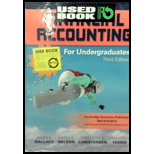
a.
Prepare an amortization schedule
a.
Explanation of Solution
Amortization of bond: The process of allocation and reduction of the discount or premium on bonds to interest expense over the life of bonds is referred to as amortization of bonds.
Effective interest method: The process of amortization that uses fixed interest rate (effective interest rate) to amortize the premium or discount on bonds is known to as effective interest method of amortization.
The effective amortization table for first two interest periods, showing the amortization of discount is prepared as follows:
Bonds Payable-Premium Amortization Table
(Effective Interest Method)
| Interest Paid | Interest Expense | Periodic Premium Amortized | Balance of Unamortized Premium | Ending Book Value | |
| 01/01/20XX | $158,342 | $958,342 | |||
| 30/06/20XX | $40,000 (1) | $38,342 (2) |
$1,666 (3) | $156,676 |
$956,676 (4) |
| 12/31/20XX | $40,000 (1) |
$38,267 (5) |
$1,733 (6) | $154,943 |
$954,943 (7) |
Table (1)
Working Notes:
Calculate interest paid on June 30 (first interest period).
Calculate interest expense on June 30 (first interest period).
Calculate premium amortized on June 30 (first interest period).
Calculate ending book value on June 30 (first interest period).
Calculate interest expense on December 31 (second interest period).
Calculate premium amortized on December 31 (second interest period).
Calculate ending book value on December 31 (second interest period).
b.
Journalize the entry for the issuance of bonds on December 31.
b.
Explanation of Solution
Prepare
| Date | Accounts and Explanations | Debit ($) | Credit ($) | |
| December | 31 | Cash (A+) | 958,342 | |
| Premium on Bonds Payable (L+) (8) | 158,342 | |||
| Bonds Payable (L+) | 800,000 | |||
| (To record issue of bonds at premium) | ||||
Table (2)
- Cash is an asset account and it is increased. Therefore debit cash account by $958,342.
- Premium on Bonds Payable is an adjunct-liability account and it has a normal credit balance therefore, debit Premium on Bonds Payable account by $158,342.
- Bonds Payable is a liability and it is increased. Therefore credit bonds payable account by $800,000.
Working Notes:
Calculate discount on bonds payable.
c.
Journalize the payment of interest and discount amortization on June 30.
c.
Explanation of Solution
Prepare journal entry:
| Date | Accounts and Explanations | Debit ($) | Credit ($) | |
| June | 30 | Bond Interest Expense (E–) | 38,334 | |
| Premium on Bonds Payable (L–) | 1,666 | |||
| Cash (A–) | 40,000 | |||
| (To record the payment of interest and amortization of premium) | ||||
Table (3)
- Bond Interest Expense is a component of
stockholders’ equity and there is a increase in the interest expense account which decreased the stockholders’ equity. Therefore debit bond interest expense account by $38,334. - Premium on Bonds payable is an adjunct-liability account. The amount has decreased because the premium is amortized; therefore, debit Premium on Bonds Payable account by $1,666.
- Cash is an asset and it is decreased. Therefore credit cash account by $40,000.
Note: Refer to requirement (a) for the values and calculations.
d.
Journalize the entry to record the payment of interest and discount amortization on December 31.
d.
Explanation of Solution
Prepare journal entry:
| Date | Accounts and Explanations | Debit ($) | Credit ($) | |
| December | 31 | Bond Interest Expense (E–) | 38,267 | |
| Premium on Bonds Payable (L–) | 1,733 | |||
| Cash (A–) | 40,000 | |||
| (To record the payment of interest and amortization of premium) | ||||
Table (4)
- Bond Interest Expense is a component of stockholders’ equity and there is a increase in the interest expense account which decreased the stockholders’ equity. Therefore debit bond interest expense account by $38,267.
- Premium on Bonds payable is an adjunct-liability account. The amount has decreased because the premium is amortized; therefore, debit Premium on Bonds Payable account by $1,733.
- Cash is an asset and it is decreased. Therefore credit cash account by $40,000.
Note: Refer to requirement (a) for the values and calculations.
Want to see more full solutions like this?
Chapter 10 Solutions
FINANCIAL ACCT.F/UNDERGRADS-W/ACCESS
- At what point do complex accounting policies become counterproductive to their intended purpose of clear financial reporting? Evaluate the balance between comprehensive documentation and practical usability in accounting systems. Is there a way to maintain thorough records without overwhelming users with excessive detail? What role should simplification play in modern accounting practices?arrow_forwardDetermine other comprehensive income for 2018arrow_forwardIf the fixed manufacturing overhead volume variance for April was $9,000 unfavorable, then the total Budgeted fixed manufacturing overhead cost for the month was$__.arrow_forward
- Please provide the accurate answer to this general accounting problem using valid techniques.arrow_forwardTartt Enterprises has inventory days of 48, accounts receivable days of 32, and accounts payable days of 27. What is its cash conversion cycle? A.) 40 days B.) 53 days C.) 65 days D.) 80 daysarrow_forwardI am trying to find the accurate solution to this financial accounting problem with appropriate explanations.arrow_forward

 AccountingAccountingISBN:9781337272094Author:WARREN, Carl S., Reeve, James M., Duchac, Jonathan E.Publisher:Cengage Learning,
AccountingAccountingISBN:9781337272094Author:WARREN, Carl S., Reeve, James M., Duchac, Jonathan E.Publisher:Cengage Learning, Accounting Information SystemsAccountingISBN:9781337619202Author:Hall, James A.Publisher:Cengage Learning,
Accounting Information SystemsAccountingISBN:9781337619202Author:Hall, James A.Publisher:Cengage Learning, Horngren's Cost Accounting: A Managerial Emphasis...AccountingISBN:9780134475585Author:Srikant M. Datar, Madhav V. RajanPublisher:PEARSON
Horngren's Cost Accounting: A Managerial Emphasis...AccountingISBN:9780134475585Author:Srikant M. Datar, Madhav V. RajanPublisher:PEARSON Intermediate AccountingAccountingISBN:9781259722660Author:J. David Spiceland, Mark W. Nelson, Wayne M ThomasPublisher:McGraw-Hill Education
Intermediate AccountingAccountingISBN:9781259722660Author:J. David Spiceland, Mark W. Nelson, Wayne M ThomasPublisher:McGraw-Hill Education Financial and Managerial AccountingAccountingISBN:9781259726705Author:John J Wild, Ken W. Shaw, Barbara Chiappetta Fundamental Accounting PrinciplesPublisher:McGraw-Hill Education
Financial and Managerial AccountingAccountingISBN:9781259726705Author:John J Wild, Ken W. Shaw, Barbara Chiappetta Fundamental Accounting PrinciplesPublisher:McGraw-Hill Education





